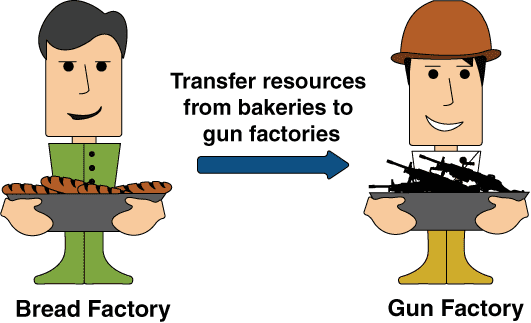The production possibility curve (PPC) displays the various possible combinations of Country A’s basket of goods. Every point on the PPC represents a combination of products that the country can manufacture. All people have to do is to decide which combination they prefer, or, in other words, choose a point on the PPC.
Scarcity
The production possibilities curve (PPC) demonstrates the effects of scarcity, which exists to some degree in every country. Scarcity results from the fact that every country has a limited amount of resources, and can produce only a limited amount of goods and services. This production output may be lower than the quantity desired by the country’s populace. Since fewer goods are produced than are desired, the consumers must choose which products are the most important to them. For every item they choose to produce, they will have to sacrifice the potential production of some other product. Producing a given item therefore has a hidden cost. This will be explained in more detail later.
Examples of Scarcity
- Example 1: With each paycheck received, Jake buys two categories of products: food and clothing. If Jake wishes to buy more food, he will have to forego buying some clothing.
- Example 2 : Country A can produce only two categories of products: food and weapons. If Country A wishes to increase the quantity of food it produces, then it will have to give up some of its weapons production.
To make things simple, assume that Country A can produce only bread and guns.

These examples assume that the country is able to produce only two items, for the following reasons:
- Two products are sufficient to explain this concept.
- A production possibilities curve on a two-dimensional graph can only show two items.
The rest of this chapter discusses two product categories as opposed to two individual items.
For example: Civilian goods and military supplies, or consumer products and capital (investment) goods.
A Basket of Goods
The two products produced by Country A comprise its “basket of goods”.
The Use of Resources
If the country wishes to bake more loaves of bread, it will have to divert resources from gun factories to bakeries. On the other hand, if the country wishes to produce more guns, it will have to transfer resources from bakeries to gun factories.
What are Resources?
Resources are the compontents of production used to create a country’s goods and services. They are sometimes called “factors of production.”
They include:
1. Human resources – workers are the most important production resource.
2. Machinery and tools are the second most important resource used in manufacturing or services.
3. Buildings are used to house factories and offices.
4. Land is used for agriculture.
When a country produces only two items, for example shoes and bread, it has to divide its available resources between the shoe and bread sectors. If the country wishes to increase the amount of bread it makes, it must divert some resources currently used in shoe production to the bread sector.
Since there are fewer resources available in the shoe sector, fewer shoes will be made. If the country wishes to make only bread, then all the resources of the shoe sector will be transferred to bakeries, no shoes will be made at all.


